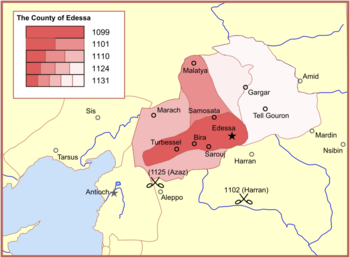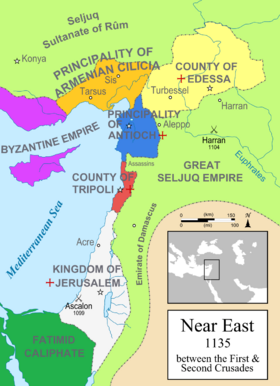County of Edessa facts for kids
Quick facts for kids
County of Edessa
Comitatus Edessanus (Latin)
Conté de Édese (Old French) ܐܘܪܗܝ ܐܲܬ݂ܪܵܐ (Syriac) Եդեսիոյ Կոմսութիւն (Armenian) |
|||||||||||||
|---|---|---|---|---|---|---|---|---|---|---|---|---|---|
| 1098–1144 | |||||||||||||
|
Coat of arms of the houses of Boulogne and Courtenay
|
|||||||||||||

The expansion of the county of Edessa prior to 1131.
|
|||||||||||||
| Capital | Edessa (1098–1144; 1146) (modern-day Şanlıurfa, Turkey) Turbessel (1144–1146; 1146–1150) (modern-day Gündoğan, Oğuzeli, Gaziantep, Turkey) |
||||||||||||
| Common languages | Latin (official/ceremonial) Syriac (popular) Old French (popular) Italian Armenian Arabic Greek |
||||||||||||
| Religion | Roman Catholicism (official), Armenian Apostolic Church, Greek Orthodoxy, Syriac Orthodoxy, Islam, Judaism (popular) | ||||||||||||
| Government | Feudal monarchy | ||||||||||||
| Count of Edessa | |||||||||||||
|
• 1098–1100 (first)
|
Baldwin I | ||||||||||||
|
• 1131–1150 (last)
|
Joscelin II | ||||||||||||
| Historical era | High Middle Ages | ||||||||||||
| 1096–1099 | |||||||||||||
|
• Establishment
|
1098 | ||||||||||||
|
• Conquered by Nur ad-Din Zengi, and the rest sold to Manuel I Komnenos
|
1144 | ||||||||||||
|
|||||||||||||
| Today part of | Syria Turkey |
||||||||||||
The County of Edessa was a special state created by European crusaders in the 12th century. It was located in a region called Upper Mesopotamia, which is now part of modern-day Turkey and Syria. The main city and capital of this county was Edessa, known today as Şanlıurfa.
During the time of the Byzantine Empire, Edessa was a very important center for learning and culture, especially for the Syriac Orthodox Church. Many ancient Greek writings were translated into the Syriac language here. These translations later helped in translating those texts into Arabic. When the Crusades began, Edessa was still important enough that some crusaders decided to go there after the Siege of Antioch.
Baldwin of Boulogne, who became the first leader (called a Count) of Edessa, later became the King of Jerusalem. The leaders who followed him in Edessa were his cousins. Unlike other Crusader states, the County of Edessa was not near the sea. It was also far from the other Crusader states and didn't always get along with its closest neighbor, the Principality of Antioch. A large part of the county, including its capital city, was located east of the Euphrates River. This made it very open to attacks. The western part of the county was controlled from a strong fort called Turbessel.
The fall of Edessa in 1144 was a major defeat for the crusaders in the Middle East. This event led to the start of the Second Crusade. However, the Second Crusade faced many problems and disagreements. It didn't even try to take back Edessa. Instead, the crusaders decided it would be better to try and capture Damascus. But that plan failed, and Edessa remained lost to the Christians.
Contents
History of the County of Edessa
How Edessa Was Founded
In 1098, Baldwin of Boulogne left the main Crusader army. This army was heading south towards Antioch and Jerusalem. Baldwin first traveled south into a region called Cilicia. Then he went east to Edessa. There, he convinced the local ruler, Thoros, to adopt him as his son and heir. Baldwin also married Thoros's daughter, Arda of Armenia. She later became the first queen of Jerusalem.
Thoros was a Christian of Armenian background, but he followed the Eastern Orthodox Church. Many of his subjects, who were Armenian Apostolic Christians, did not like him. This led to him losing power in March 1098. Some historical records say he was killed, while others say he gave up his rule. Historians still debate if Baldwin played a part in this. Regardless, Baldwin took over as the new ruler, becoming the Count of Edessa.
In 1100, Baldwin became the King of Jerusalem after his brother, Godfrey of Bouillon, died. The County of Edessa then passed to his cousin, Baldwin of Bourcq. He was joined by Joscelin of Courtenay. Joscelin became the lord of the fortress of Turbessel, which was an important outpost against the Seljuk Turks.
The Frankish (European) lords often got along well with their Armenian subjects. There were many marriages between them. The first three Counts of Edessa all married Armenian women. Count Baldwin's first wife had died, and he married Arda, a granddaughter of an Armenian prince. Baldwin of Bourcq married Morphia, a daughter of another Armenian ruler. Joscelin of Courtenay also married an Armenian princess.
Fights with Muslim Neighbors
Baldwin II quickly became involved in events in northern Assyria and Asia Minor. In 1103, he helped get Bohemond I of Antioch released after he was captured by the Danishmends. In 1104, Baldwin and Antioch attacked the Byzantine Empire in Cilicia.
Later in 1104, the city of Edessa was attacked by forces from Mosul. Both Baldwin and Joscelin were captured after they lost the Battle of Harran. Tancred, Bohemond's cousin, became the temporary ruler in Edessa. Baldwin and Joscelin were finally set free in 1108. Baldwin had to fight to get back control of Edessa. Tancred was eventually defeated, but Baldwin had to make alliances with some local Muslim rulers to succeed.
In 1110, all the lands east of the Euphrates River were lost to Mawdud of Mosul. However, Mawdud did not attack Edessa itself. The Muslim rulers were more focused on strengthening their own power at that time.
Baldwin II became King of Jerusalem (also as Baldwin II) when Baldwin I died in 1118. Even though Eustace of Boulogne, Baldwin I's brother, had a stronger claim, he was in France and did not want the title. Edessa was then given to Joscelin in 1119. Joscelin was captured again in 1122. When Baldwin came to rescue him, he was also captured. This left Jerusalem without its king. Joscelin escaped in 1123 and helped Baldwin get released the next year.
The Fall of the County
Joscelin was badly hurt during a siege in 1131. His son, Joscelin II, took over as Count. By this time, a powerful leader named Zengi had united the cities of Aleppo and Mosul. He began to threaten Edessa.
Meanwhile, Joscelin II did not pay much attention to protecting his county. He also argued with the leaders of Tripoli, who then refused to help him. Zengi attacked the city in 1144 and captured it on December 24 of that year. Joscelin continued to rule his lands west of the Euphrates. He also managed to take advantage of Zengi's death in September 1146 to briefly take back his old capital. However, the city was lost again in November, and Joscelin barely escaped.
In 1150, Joscelin II was captured by Zengi's son, Nur ad-Din. He remained a prisoner in Aleppo until he died in 1159. His wife sold Turbessel and the remaining parts of the county to the Byzantine Emperor Manuel I Comnenus. But these lands were quickly conquered by Nur ad-Din and the Sultan of Rum within a year. Edessa was the first Crusader state to be created, and it was also the first one to be lost.
People and Population
Edessa was one of the largest Crusader states in terms of land area. However, it had one of the smallest populations. The city of Edessa itself had about 10,000 people. The rest of the county was mostly made up of forts. At its largest, the county stretched from Antioch in the west to across the Euphrates River in the east. It also often included land as far north as Armenia. To the south and east were the powerful Muslim cities of Aleppo and Mosul, and the region of Jazira (northern Iraq).
Most of the people living in Edessa were Syriac Orthodox and Armenian Orthodox Christians. There were also some Greek Orthodox Christians and Arab Muslims. Even though the number of Latin (Catholic) Christians remained small, there was a Roman Catholic archbishop. The fall of the city in 1144 was the main reason for the start of the Second Crusade in 1146.
Government
The County of Edessa was a Feudal monarchy. This means it was ruled by a Count, and the land was divided among lords who swore loyalty to him.
Counts of Edessa
- Baldwin I (1098–1100)
- Baldwin II (1100–1118)
- Tancred of Galilee was a temporary ruler (regent), with Richard of Salerno as governor (1104–1108)
- Joscelin I (1118–1131)
- Joscelin II (1131–1144, died 1159)
- Joscelin III, a Count in name only after 1159
- Beatrice, a Countess in name only from 1200
Lordship of Turbessel
Turbessel was an important fort located west of the Euphrates River. It was first ruled by Joscelin I before he became the Count of Edessa. It helped protect the border against Antioch. Later, it became a special holding for the Courtenay Counts of Edessa. After the city of Edessa was lost, Turbessel became their main base. It was sold to the Byzantines just before it was conquered by Muslims. After the sale, Joscelin II's wife and family moved to the Kingdom of Jerusalem, near Acre.
See also
- Vassals of the Kingdom of Jerusalem



